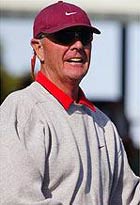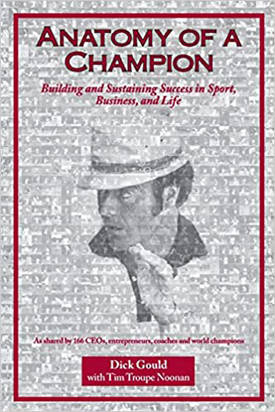Learning From
the Greats
By Dick Gould
Watch the great players in tennis. Legends like Andre Agassi,or young champions like Roger Federer, Andy Roddick, or Maria Sharapova. Champions who thrill us with their play and will leave their mark on the game. All with their own individual style.
No one can say that there is only one way to hit a tennis ball. There are a wide variety of grips. Top players play with one hand or two. They hit the ball flat, or with heavy top spin or with under spin on the one-handed backhand. They play on the base line or 12 feet behind it or advance to the net at every opportunity, and also mix styles in every possible variation and degree.
Fundamentals
The way every player combine these possibilities in his own game is unique. Every player should develop as an individual and create his own style. And this includes you! The one thing all successful styles share however is that they are all based on sound principles.
One reason the great players are great is their mastery of the fundamentals that are
common to all good strokes. Good fundamentals make it fun to hit the tennis ball and they lead to
competitive success. In this article I want to outline some of these basic principles.
It is possible to develop superior ground strokes with a variety of grips. Effective grips can include an Eastern grip like Sampras or Tim Henman or Federer, a grip which aligns most of the palm of the hand with the racket face. More common in the pro game are the semi-western grips like Andre Agassi or Andy Roddick which shift the palm of the hand partially or even mostly underneath the frame.
But the ground strokes of all these tennis players share certain fundamentals. First, early preparation. Well before they hit the ball, good players are in position, both with their rackets and with their bodies.
Good preparation leads to good execution. The key to this preparation is in the
feet and the shoulders. They all initiate the movement to the ball by stepping in the direction
of the shot and turning my shoulders.
The key is to arrive at the ball prepared to hit with your shoulders turned and
the racket preparation complete. Typically for pro players this will be with the racket at or
near the top of the backswing. Even at the high velocity of pro tennis, the great players never
seemed rush because of their superior preparation.
A second fundamental: keep the back swing as compact as possible. Watch great players and see how little arm and racket movement they use in preparing to hit their ground strokes. Often times they are much more compact than club players, or even successful junior tournament players.
Your hitting arm stays in close to the body so the power of the stroke is generated
from the rotation of the shoulders and from the legs. Despite their very different swing styles,
Agassi, Roddick, Federer and Sampras all use the body for power, not the arm.
A third fundamental. Whatever your grip, develop a disciplined swing pattern that you can repeat consistently under pressure.
A final more advanced key, experiment with taking the ball on the rise. Your shot will automatically have more power and you will reduce the amount of time your opponent has to respond to your shot.
The Volley
Players like Sampras, Federer or Tim Henman make the volley look simple. Simplicity is the key to developing great volleys yourself.
To become the best volleyer you can be, you must learn to volley with one grip, the continental grip, roughly between the forehand and the backhand. The continental grip gives you flexibility because it allows you to hit balls at all heights and to hit your volleys relatively flat or with increased underspin for touch and control.
Keep the back swing to a minimum. As with the ground strokes, the racket
preparation is initiated with the step to the ball and with the shoulders. Watch how
this keeps the racket movement to a minimum.
A second volley fundamental: make contact with the ball well in front of your body. Watch the ball all the way on to your racket. Generate your pace from the pace on the oncoming ball. There is little back swing and a short follow through. Another volley key: stay on balance; keep your knees bent, the weight forward and the body basically erect.
For the serve, the grip most pros use is between the continental grip and the eastern back hand grip. A key to the service motion is relaxation. Too much muscle tension will actually cause you to lose velocity, not gain it.
The motion should be full and free as the racket drops along the side of the back. It should be equally free as it accelerates up to the contact point. Note how the tip of the racket pronates forward out into the direction of the shot. This rotation of the arm provides an important source of added power. The follow through is also relaxed and it finishes naturally across the body.
Use your legs for more power. Watch the tremendous knee bend that players like Roddick
get on their serves. As the legs uncoil, this energy is translated in increased spin and ball velocity.
Develop confidence in your second serve. It is critical to learn to generate spin by hitting up and over the ball. Visualize making contact with the underside of the ball with the racket head brushing across the face of the ball upward and from the left to the right.
This will create kick or top spin. It will help to make your second serve consistent under pressure and difficult to attack.
Good fundamentals require practice. To become the player you want to be, you should work hard in developing every aspect of your game.
Practice with a purpose. Divide your time equally amongst all of your shots from back court rallies to approaches in net play. Don't forget the serve and equally important are your serve return and your passing shots.
Make your practice and all these fundamentals game specific. Do drills that simulate the actual
patterns and shot combinations that you must execute to be successful in match play. Developing the skills to
be a complete player is challenging. But make it fun, too, and tennis will be a sport you enjoy
for a lifetime.





